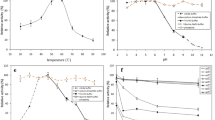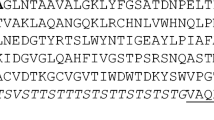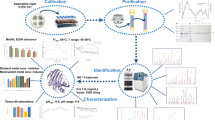Abstract
Aspergillus flavus K49 secreted at least two xylanase activities when grown on a medium containing larch (wood) xylan as a sole carbon source. Enzyme activity was assayed using an agar medium containing Remazol Brilliant Blue R conjugated oat spelt xylan as substrate. Crude enzyme preparations were inhibited by Hg+2, with an ED50 of 17.5 mM and maximum inhibition of 83% at 50 mM. A concentrated sample of A. flavus K49 xylanase preparation was subjected to gel filtration chromatography on a P-30 column. A small protein peak coinciding with the major peak of xylanase activity was separated from the other secreted fungal proteins. An additional peak of xylanase activity was observed in fractions containing multiple fungal proteins. Analysis by denaturing sodium dodecyl sulfate–polyacrylamide gel electrophoresis (SDS–PAGE) of fractions containing the smaller molecular weight xylanase revealed a major and minor protein band in the vicinity of 14 kD. Analysis of these same fractions by acidic native PAGE revealed a single band. Confirmation of identity for the isolated xylanase was provided by isolation of a protein band from a SDS–PAGE gel, followed by trypsin digestion/analysis by tandem mass spectrometry. Comparison of the peptide library derived from this protein band with sequence data from the A. oryzae genomic data base provided a solid match with an endo-1,4-β-xylanase, XlnA. This identification is consistent with a low molecular weight protein associated with the major xylanolytic activity. XlnA may be a highly mobile (diffusible), plant wall hemicellulose degrading factor with significant activity during plant infection.




Similar content being viewed by others
References
CAST (Council for Agriculture Science and Technology). Mycotoxin risks in plant, animal and human systems. CAST Task force report #139, Ames, IA; 2003.
Mellon JE, Cotty PJ, Dowd MK. Aspergillus flavus hydrolases: their roles in pathogenesis and substrate utilization. Appl Microbiol Biotechnol. 2007;77:497–504.
Cosgrove DJ. Relaxation in a high-stress environment: the molecular bases of extensible cell walls and cell enlargement. Plant Cell. 1997;9:1031–41.
de Vries RP, Visser J. Aspergillus enzymes involved in degradation of plant cell wall polysaccharides. Microbiol Mol Biol Rev. 2001;65:497–522.
Mellon JE, Cotty PJ. Preliminary purification and characterization of a xylanase activity from Aspergillus flavus. In: Proceedings, Beltwide cotton conferences. 2007. p 147–152.
Abbas HK, Zablotowicz RM, Weaver MA, Horn BW, Xie W, Shier WT. Comparison of cultural and analytical methods for determination of aflatoxin production by Mississippi Delta Aspergillus isolates. Can J Microbiol. 2004;50:193–9.
Adye J, Mateles RI. Incorporation of labeled compounds into aflatoxins. Biochim Biophys Acta. 1964;86:418–20.
Cotty PJ. Aflatoxin and sclerotial production by Aspergillus flavus: influence of pH. Phytopathology. 1988;78:1250–3.
Biely P, Mislovicova D, Toman R. Soluble chromogenic substrates for the assay of endo-1, 4-β-xylanases and endo-1, 4-β-glucanases. Anal Biochem. 1985;144:142–6.
Schägger H, von Jagow G. Tricine-sodium dodecyl sulfate-polyacrylamide gel electrophoresis for the separation of proteins in the range from 1 to 100 kDa. Anal Biochem. 1987;166:368–79.
Blum H, Beier H, Gross HJ. Improved silver staining of plant proteins, RNA and DNA in polyacrylamide gels. Electrophoresis. 1987;8:93–9.
Reisfeld RA, Lewis UJ, Williams DE. Disk electrophoresis of basic proteins and peptides on polyacrylamide gels. Nature. 1962;195:281–3.
Laemmli UK. Cleavage of structural proteins during the assembly of the head of bacteriophage T4. Nature. 1970;227:680–5.
Altshul SF, Gish W, Miller W, Myers EW, Lipman DJ. Basic local alignment search tool. J Mol Biol. 1990;215:403–10.
Mellon JE, Helgeson JP. Interaction of a hydroxyproline-rich glycoprotein from tobacco callus with potential pathogens. Plant Physiol. 1982;70:401–5.
de Vries RP. Regulation of Aspergillus genes encoding plant cell wall polysaccharide-degrading enzymes; relevance for industrial production. Appl Microbiol Biotechnol. 2003;61:10–20.
Frederick MM, Kiang C-H, Frederick JR, Reilly PJ. Purification and characterization of endo-xylanases from Aspergillus niger. I. Two isozymes active on xylan backbones near branch points. Biotechnol Bioengin. 1985;27:525–32.
Kumar S, Ramón D. Purification and regulation of the synthesis of a β-xylosidase from Aspergillus nidulans. FEMS Microbiol Lett. 1996;135:287–93.
van Peij NNME, Gielkens MMC, de Vries RP, Visser J, de Graaff LH. The transcriptional activator XlnR regulates both xylanolytic and endoglucanase gene expression in Aspergillus niger. Appl Environ Microbiol. 1998;64:3615–9.
Marui J, Tanaka A, Mimura S, de Graaff LH, Visser J, Kitamoto N, Kato M, Kobayashi T, Tsukagoshi N. A transcriptional activator, AoXlnR, controls the expression of genes encoding xylanolytic enzymes in Aspergillus oryzae. Fungal Genet Biol. 2002;35:157–69.
Piñaga F, Fernández-Espinar MT, Vallés S, Ramón D. Xylanase production in Aspergillus nidulans: induction and carbon catabolite repression. FEMS Microbiol Lett 1994;115:319–324.
Tilburn J, Sarkar S, Widdick DA, Espeso EA, Orejas M, Mungroo J, Peñalva MA, Arst HN Jr. The Aspergillus PacC zinc finger transcription factor mediates regulation of both acid- and alkaline-expressed genes by ambient pH. EMBO J. 1995;14:779–90.
MacCabe AP, Orejas M, Pérez-González JA, Ramón D. Opposite patterns of expression of two Aspergillus nidulans xylanase genes with respect to ambient pH. J Bacteriol. 1998;180:1331–3.
Acknowledgments
The authors thank Bobbie J. Johnson for excellent technical assistance, and Dr. George Tsaprailis and the Arizona Proteomics Consortium of the University of Arizona for their assistance in conducting the MS analysis of the 14-kD protein. Mention of trade names or commercial products in this article is solely for the purpose of providing specific information and does not imply recommendation or endorsement by the USDA.
Author information
Authors and Affiliations
Corresponding author
Rights and permissions
About this article
Cite this article
Mellon, J.E., Cotty, P.J., Callicott, K.A. et al. Identification of a Major Xylanase from Aspergillus flavus as a 14-kD Protein. Mycopathologia 172, 299–305 (2011). https://doi.org/10.1007/s11046-011-9425-7
Received:
Accepted:
Published:
Issue Date:
DOI: https://doi.org/10.1007/s11046-011-9425-7




